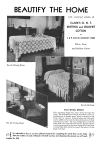BEAUTIFY THE HOME
FUNDRAISING
OUR FUNDRAISING CAMPAIGN HAS NEARLY ENDED! GOAL: 5000 USD AND CURRENTLY AT 99%!
To keep our Library up and running, we hold a fundraising campaign from September to December.
This is the link to the donation button: Donate to keep the Antique Pattern Library running!
If you can’t afford to donate, but would like to help the Antique Pattern Library, introducing the Library to people who don’t know of it yet, is very useful, since it broadens our user base and therefore also our future donor base. Blogs, Tiktok, Instagram, Pinterest, Ravelry, Facebook, other social media – show others your favorite publications and what you made using them. Our work is only useful when people actually use it!
If that is not possible either, just enjoy our new publications either for inspiration or for your own work!
NEW PUBLICATION

J-PA277 The Spool Cotton Company Leaflet 558 – Beautify the Home
Folded sheet, 4 pages. Beautify the home with crocheted articles of Clark’s O.N.T. Knitting and Crochet Cotton or J. & P. Coats Crochet cord. White, Ecru, and boilfast Colors. For the Dining Room, For the Bedroom, for the Living Room. Three patterns: Star Wheel Design No. 200 (small and large motifs), Tufted Fern Block No. 201, and Luncheon or Tea Set No. 220.
From the collection of Iva Rose Reproductions, scanned by Nettie Kraaij, edited by Sytske Wijnsma.
Printed in 1934, this leaflet offered the homemakers a glow-up for their household by spending money only on thread, and take on the labor themselves. Since this was during the Great Depression, marble kitchen tops and hardwood floors were not an option. Textiles, especially when made by the members of the household, were a cheaper way to dress up furniture and indeed, beautify their home, as well as showing off their prowess in needlework. There were times that being an excellent needleworker meant one was lower-class, since only they did so much work that they became near-perfect, and real ladies were supposed to show some capability but definitely not do good work. The Great Depression has swept away some of that mindset and ever since, good needleworkers have been somewhat more appreciated.